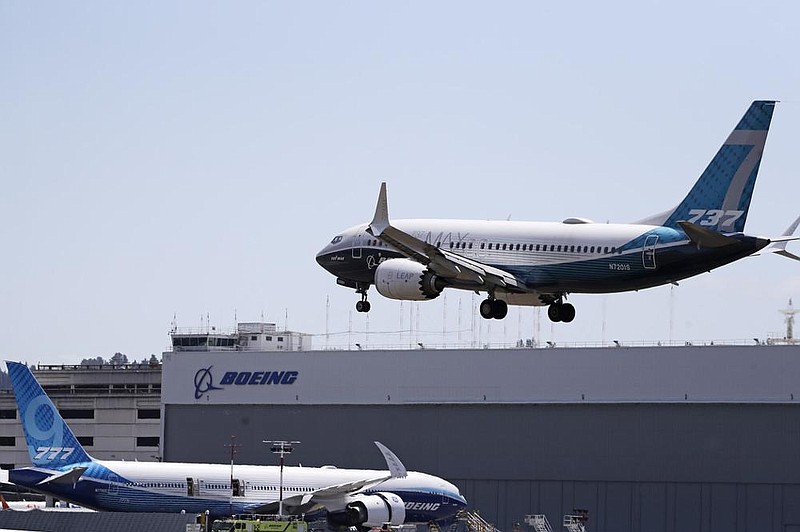Boeing Co. provided only "limited information" on the flight-control software later implicated in two fatal crashes on the 737 Max as it was being approved by federal regulators, a government watchdog report has found.
The Transportation Department's inspector general concluded that Boeing didn't fully communicate to Federal Aviation Administration officials changes to a system that automatically pushed down the jet's nose. That led the regulator to focus on other issues in its review of the plane.
Engineers for the Federal Aviation Administration didn't perform a detailed examination of the flight-control system until after the first crash, in October 2018 off the coast of Indonesia.
The highly anticipated report, dated Monday and released Wednesday morning, paints a critical picture of Boeing. It was reviewed by Bloomberg News before its release.
Boeing's bestselling jet has been grounded since March 2019 after the second of two crashes that killed 346 people. While some of the details released by the inspector general have been contained in other investigative reports or news articles, the latest report contains the most extensive timeline of the plane's approval to date.
Boeing, in a statement, said that it has cooperated with the investigation and made "robust improvements" to the flight-control system. "We are committed to transparency with the FAA during all aspects of the airplane certification process, and have made significant changes to improve our support to that regulatory process," the company said.
In early development of the Max, Boeing indicated the flight control software, called the maneuvering characteristics augmentation system, would not activate the system often, and so the system didn't receive a detailed review by FAA. In 2016, as the plane was going through test flights, Boeing changed the system to increase its power to turn the nose down under some conditions. But the company did not submit documents to the FAA detailing this change, the inspector general found.
FAA flight-test personnel knew, "but key FAA certification engineers and personnel responsible for approving the level of airline pilot training told us they were unaware of the revision to [the system]," the inspector general said.
The FAA began reviewing its certification of the flight-control system more than two months after the Indonesian crash. It was the first time agency engineers had taken a detailed look at the system, according to the report.
PLANS FOR LEGISLATION
Two U.S. lawmakers with responsibility for overseeing the aviation industry said they'd use the report to craft legislation to prevent such missteps in the future.
"The more scrutiny we put on Boeing and the FAA, and the more we dig into why and how the system failed so horribly and led to the deaths of 346 innocent people, the better chance we have of fixing the system to ensure no family has to endure this nightmare again," said Rep. Peter DeFazio, D-Ore., who is chairman of the House Transportation Committee.
DeFazio was joined by Rep. Rick Larsen, D-Wash., who is chairman of the panel's aviation subcommittee.
In a response included in the report, the FAA acknowledged that its certification of the jet was hampered by a lack of effective communication with Boeing and within the agency. This led to "an incomplete understanding of the scope and potential safety impacts" of the changes to the system that helped lead to the crashes.
The report revolves around the approvals for the Maneuvering Characteristics Augmentation System. It was added to the plane to nudge the nose down in certain high-risk conditions so that the aircraft complied with federal regulations.
However, in both crashes -- one off the coast of Indonesia in October 2018 and the second near Addis Ababa, Ethiopia, in March 2019 -- a malfunction caused it to repeatedly attempt to dive the planes. Pilots in both cases lost control. The Max has been grounded globally since days after the Ethiopian crash.
OVERSIGHT REVISIONS
The FAA is revising its oversight of the program that permitted designated employees of a manufacturer to perform certification work and will release details in coming months.
"This and other reviews, both completed and ongoing, will inform important reforms of FAA's aircraft certification process," the FAA response said.
Daniel Putut, managing director of Lion Air Group, operator of the 737 Max involved in the first crash, declined to comment on the inspector general's report. He said the airline, one of the biggest customers for the Max, will make a decision on its future at the carrier "only after the full re-certification process from regulators and the return-to-service program provided by Boeing."
A spokesman for Ethiopian Airlines Group, operator of the plane involved in the second crash, said he hadn't seen the report and couldn't comment. The company has said it will be last carrier to fly the Max after it resumes service.
Information for this article was contributed by Alan Levin and Julie Johnsson of Bloomberg News and by David Koenig of The Associated Press.
